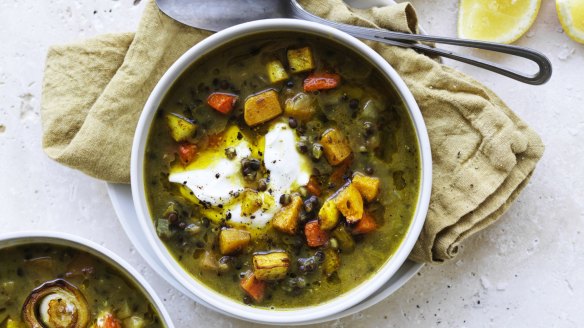The best grains and pulses to add to soups

What is the best grain or pulse to add to soup? K. Hendricks
One of the best things about Britain is BBC Radio Four, and one of its great program is Kitchen Cabinet. It is like a radio version of this column, with vexing questions answered by a panel of food experts. One of the regular panellists is food historian Dr Annie Gray, who recently explained that the expression "stick to your ribs" referred to a soup so thick that its contents, most likely peas or barley, would cling to the pork or lamb ribs used to flavour the soup.
This year I have been making vegetable soup with lamb neck using Australian barley to support our farmers. I am particularly fond of the barley from Burrum Biodynamics, which they grow without using artificial fertilisers or pesticides. Barley plumps up beautifully and exudes a rich, silky starch that thickens soups beautifully. Add to these some French-style lentils in the last 30 minutes of cooking. I like the lentils from Mount Zero Olives.
When combined in a dish, grains and pulses give you the full range of proteins required for a healthy diet, making them very suitable, even recommended for vegetarians. But are they the best grains or pulses for soup? It's horses for courses.
You need split peas to make pea and ham soup, and marrowfat peas if you're from the north of England and making mushy peas. If you were to make a Greek avgolemono (chicken and lemon soup), you'd need short-grained rice, and if you're in Iceland simmering lamb soup, kjotsupa, you would need oats.
Whole grains and pulses are packed with fibre and important nutrients. They are incredibly affordable and add body and flavour to soups. Because of their slightly earthy note, it is often good to finish a soup laden with grains and pulses with a top note of perhaps lemon or yoghurt and a hint of green such as fresh parsley or dill.
How do you rest meat but still get it piping hot on the plate? P. Thomson
All cooked muscle eats better after it has been rested; this includes fish and even sausages. To rest your joint, chook, snorkers or steak, place it on a warmed plate, cover with foil and leave in a warm place. During that time, the meat will continue to cook for a short period as the heat distributes evenly. Then, the cooking juices that were forced out as the muscles constricted will migrate back into the meat. These protein-rich juices then begin to thicken, so that when you cut into the meat, they remain in the flesh rather than oozing onto your plate.
To rest, many chefs use the one minute per 100g rule. So, a sausage will need just a few minutes, a steak three to five minutes, and a roast 10 to 20 minutes. It is important that any juices that do emerge on the resting plate are returned to the dish. These could be incorporated into the sauce or gravy, if you are making one, or simply poured back over the meat.
Now, about that piping hot issue. Your meat will not go off in the short time it is resting, so don't worry about that. If you heat the food up again, the juices will start flowing again, and the meat won't eat as well, becoming dry when you chew it. So keep the meat warm by heating the serving plates and making sure the sauce or gravy is hot.
Send your vexing culinary conundrums to brainfood@richardcornish.com.au or tweet to @foodcornish
Appears in these collections
- More:
- Food
- Brain food
